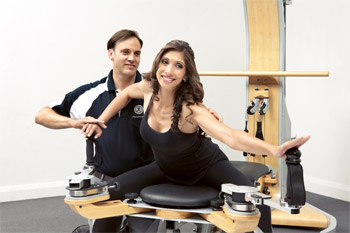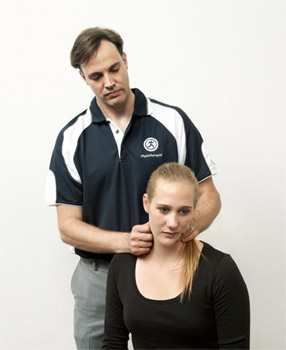Matthew Squires Musculoskeletal Back Pain Interview

Matthew Squires Musculoskeletal Back Pain Interview
Musculoskeletal back pain is estimated to have affected 70-90% of the Australian population at some point in their lives. The majority of those that suffer have experienced 'simple' back pain, however others may suffer from neural pain (sciatica), structural pain (scoliosis) and chronic back pain.
Matthew Squires, Founder of Physio Gym physiotherapy estimates that up to 50% of his members seek out physiotherapy because of lower back pain. According to Squires, simple back pain is generally caused by mechanical overload of soft tissue such as the muscles, disc and ligaments in the spine. This can be caused by prolonged sitting, poor posture, incorrect lifting and physical stress.
A person with lower back pain is 2.4 times more likely to consider their health as poor and 2.6 times more likely to have psychological distress. "Because so many people suffer from this condition, a lot of the time it is brushed off as 'one of those things'. However, we know that this kind of pain can significantly impact a person's life in a very negative way," says Squires. "Thankfully, there are a variety of ways people who lead a sedentary lifestyle and/or job can treat this pain."
Squires advises that sufferers should always seek advice for a diagnosis initially before applying manual therapy that specifically targets the injured tissue. This should then be followed by targeted exercises to relieve pain. Critically, a rapid response approach in the first two weeks can focus your brain to help heal the body to prevent the chances of developing long term recurrent back pain.
"I always say that people need to counter the effect of prolonged sitting by doing five minutes of exercise for every hour that is spent sitting. This might not sound like much but 3.5 hours of exercise a week, for someone who works a 40 hour week, can make a dramatic difference," says Squires. "We're not designed to sit down for 8-12 hours a day, so it is not surprising that so many Australians suffer from lower back pain. It's the equivalent of driving from Sydney to Byron Bay and half way back in a day! Unsurprisingly, many professionals complain of feeling drained and exhausted after a long day staring at the screen."
Squires also suggests that professionals should keep a glass of water on their desk, rather than a large 2L bottle, to force them to get up and refill it regularly. Furthermore, he advises doing regular stretches while sitting such as neck, shoulder and spinal twists and hip flexor stretches.
For a meaningful, long-term solution, Physio Gym physiotherapy specialises in the GYROTONIC® method, a clinically proven process of combining specific equipment and targeted exercises to resolve pain and build the resilience of the spine. The system is even used by the likes of Madonna for fitness, and Andy Murray to recover from back pain. The equipment re-trains the body, coordinates the movements, corrects compensatory movements and trains the core.
The method systemically builds the core strength of the body and links it into the movements of the arms and legs. It differs to Pilates because it encourages the occurrence of spinal dynamic movements. It also explores the rotation elements of the spine to correct muscle imbalances, correct stiff joints and elongate the spine.
"It is a proven fact that back pain can affect your home life, work life, fitness and mental health. Knowing how to combat this pain, through simple 'at-home' methods and through more significant solutions with the aid of a physiotherapist, is key in leading a happy and productive life," says Squires.
 Squires top 5 tips for easing the symptoms of back pain at work:
Squires top 5 tips for easing the symptoms of back pain at work:
People should spend five minutes of exercise for every hour that is spent sitting (e.g. if you work a 40 hour week, you need to do at least 3.5 hours of exercise)
Keep a glass of water on your desk, rather than a larger bottle, to force you to get up and refill it
Do regular stretches while sitting such as neck, shoulder and spinal twists and hip flexor stretches
Talk to your superiors about investing in ergonomic equipment
Schedule a 'walk and talk' meeting - you'd be surprised how quicker you get through an agenda when you're on your feet!
For more information visit www.physiogym.net.au
Interview with Matthew Squires
Question: What is musculoskeletal pain?
Matthew Squires: Musculoskeletal pain often is a symptom of lower back pain. It occurs from the muscles, ligaments, joints and bony tissue being injured, stressed or over worked. Once there is damage or stress then inflammation often occurs causing pain. In some cases pain may arise from muscles that have trigger points or are cramping.
Question: What are the common causes of lower back pain?
Matthew Squires: Lower back pain is commonly caused by poor alignment of the body's structure, overloaded joints due to sustained sitting, poor lifting techniques. Women can get back pain during pregnancy due to the dramatic loads on the spine and after birth due to compromised abdominal and pelvic floor muscles.
Question: How are our sedentary lifestyles creating lower back pain?
Matthew Squires: A sedentary lifestyle often means sitting longer. With this there is significant wasting of muscles that are designed to move the body in an upright position. Our postures often change to suit the environment and people developed hunched postures overloading the discs in the back. Weight gain often results over time which makes motivation and the capacity to exercise harder.
Question: Can we cure our lower back pain without giving up our office jobs?
Matthew Squires: Yes, by creating good habits at work such as getting up regularly form the computer, standing at a high desk, touch typing, having good chairs and stretching regularly.
Question: How many hours of activity are required when we spend 8+ hours sitting in an office chair?
Matthew Squires: I recommend for every 1 hour sitting you need to do 5 minutes exercise to minimise the chance of back pain. That is at least 3.5 hours of structured exercise per week.
Question: Can you talk us through the correct way to sit at our desks?
Matthew Squires: The basics include: Sit on a chair that has a good back rest and you are able to feel supported, upright and at a height your feet touch the ground. If you are short you may need a foot rest. If you are tall you can raise the table with blocks. Keep the screen at eye line height. However remember to have the capacity to change your posture. Try not to sit always in one position and on the one chair.
Question: What is ergonomic equipment?
Matthew Squires: Ergonomic equipment is designed to maximise the shape of the body with the environment you are working in. There are ergonomic keyboards shaped to assist the position of the wrist. Chairs are particularly important as some chairs are designed to support the body whilst others are designed to make the body work and encourage better posture.
Question: Does a standing desk help aid the issues of lower back pain?
Matthew Squires: Yes a standing desk will help with lower back pain. It moves the pressure of the buttocks and into the back into the feet and pelvis. However, make sure when standing you don't put to much pressure on the neck and arms by having everything elevated.
Question: Can you talk us through the types of stretches we should do whilst at our desks?
Matthew Squires: Hip Flexor stretches can be as simple as pushing one of your legs behind you whilst sitting on a chair.
A spinal twist involves twisting to the right and looking behind you.
Glute stretches include crossing the thighs and then twisting to the side that the leg is highest.
Question: What is the GYROTONIC® method?
Matthew Squires: The GYROTONIC(R) method is a dynamic form of core training that focuses on training the spine how to move. I encourages the spine to rotate and elongates the spine through flowing movements. It trains the body for an upright spine, specifically for sitting, and is great to counteract the effect of static sitting.
Interview by Brooke Hunter
MORE



